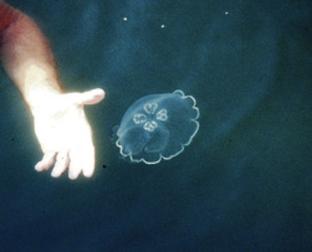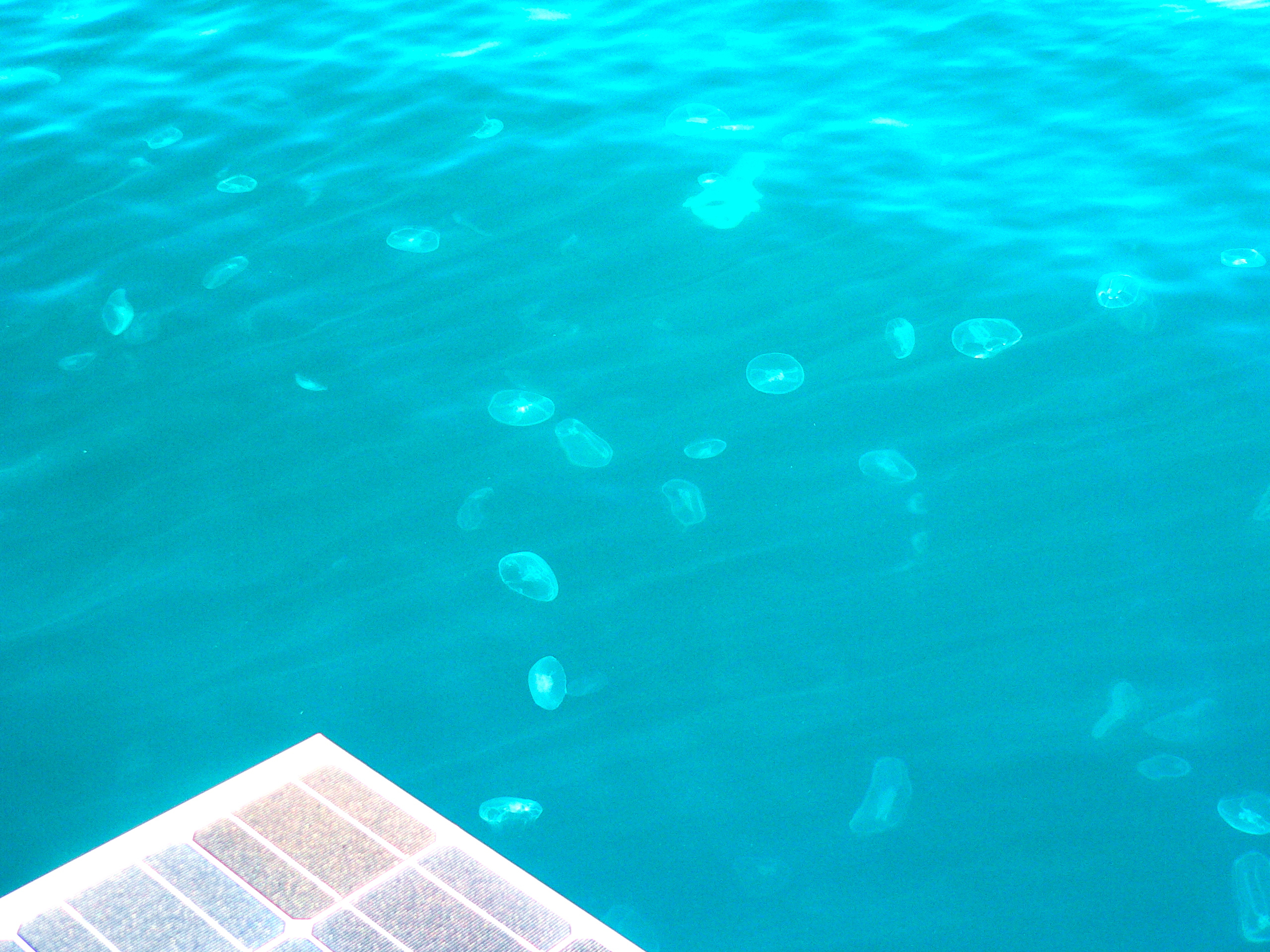Published in the Ocean Watch column, Honolulu Star-Advertiser © Susan Scott
July 4, 2011
This email came from reader John Swindle: “Decades ago I used to swim at Ala Moana Beach, usually near sunset. I noticed that as soon as the sun went down, I’d feel things gently bumping me. This wasn’t near the rocks, where life was abundant, but rather in the channel or near the shore. Sure, it meant it was time to go in, but what was bumping me and why? The candidates that I recall seeing in daylight around there were jellyfish of some kind, limu (gets territorial at night?) and weke.”
 Courtesy Susan Scott
Courtesy Susan Scott
Moon jellies often swim around to find water
rich in animal plankton and then stay there.
I don’t know about claiming territory, but limu sure can embarrass a person. Running into a clump of it while swimming causes me to leap from the water with heart pounding. When I see what attacked me, I glance around, hoping no one saw me freaking out over a plant. These run-ins with limu, however, usually feel more like a prickle than a bump.
And weke? If a goatfish bounces off a person, the fish is either dead or insane. Goatfish don’t bump.
I think the bumpers were moon jellies.
To most people jellyfish are creepy and dangerous, and in some cases it’s true. Jellyfish look like gooey space aliens, and many have terrible trailing tentacles. Some species’ stings bring the toughest ocean-goers to their knees, and Australia’s box jellyfish can even kill a person.
But not moon jellies. These attractive, entertaining creatures are the SpongeBobs of jellyfish.
Moon jellies can’t sting us. The fringe of tentacles around the outside of their domelike bodies kills and captures tiny animals adrift, but the stingers don’t have enough oomph to penetrate human skin.
Some say that moon jellies cause a stinging sensation if they touch your mouth, but that has not been my experience. Several times moon jellies have kissed me on the lips while I was snorkeling, and I felt only a slight tingle. (The jellyfish version of love?) And when their round white bodies, which can be big as soup bowls and pretty as bone china, ran into my body, the thumps had all the impact of wet marshmallows.
Besides being harmless, moon jellies are nature’s own lava lamps, swimming with gentle hypnotic contractions.
Occasionally moon jellies have population explosions in the Ala Wai Boat Harbor, and the sight of thousands of these round, white jellyfish of all sizes is a wonder to behold. Watching them pulse is meditation marine style.
 Moon Jellies in Neiafu, Vava’u Islands, Tonga
Moon Jellies in Neiafu, Vava’u Islands, Tonga
I have admired moon jellies for years and often wondered how, with tides coming and going twice daily, these drifters remain in and around the harbor for months at a time.
The answer is that they are not drifters. Moon jellies are swimmers with a mission: to find water rich in animal plankton and stay there.
Researchers studying moon jellies off Vancouver, British Columbia, have discovered that these (and perhaps all) jellyfish are smarter than anyone thought. Moon jellies have central nervous systems, including brains, and use them to navigate.
When the tide starts carrying the jellies out to sea, they dive down to still water and wait there. When the tide turns, the creatures rise up and ride the current back home.
Besides being brilliant, moon jellies are, for jellyfish, friendly. If I had to choose between attacks by feral limu, rushes by crazy goatfish or bumps by moon jellies, there’s no question. I would much rather be mooned.
Thanks, John, for the fun email.